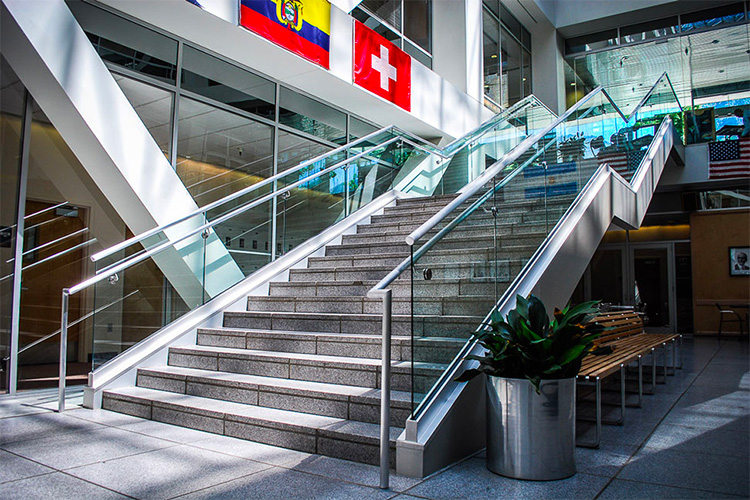Glass Railing: Building Code Considerations
February 16, 2022
Read the full original article here
Glass railings lend an effortlessly modern visual appeal to both exteriors and interiors. However, glass railing code requirements need to be met in order to comply with safety guidelines and earn inspection approval.
No matter the material you choose, a railing that is not to code presents safety issues and will result in costly construction delays and the need for reinstallation. Decisions about aesthetics or cost-effectiveness, from glass material choice to the inclusion of a top hand rail, have significant impact on safety guidelines and installation. Beyond coding, substandard railing construction can also lead to unsightly imperfections and inconsistencies that diminish the quality of its overall appearance.
In this post Morse Architectural will list some of the codes you’ll need to consider for your glass railing project to ensure you get the most value from your railing installation.
Requirements to be aware of
When choosing a glass railing system always compare its specifications against standard glass railing code requirements. Here are some some key code considerations to be aware of:
International Building Code (IBC) — The International Building Code is considered a foundational building safety standard by governments and regulators around the globe. Known for balancing safety with ease of use, the IBC is a base level of protection that architects and contractors should adhere to in order to ensure public wellbeing.
The IBC is revised every three years. It’s important to note that not all cities or counties utilize the most recent version of IBC — some still use previous versions.
The 2018 IBC railing requirements state that fully tempered or heat strengthened laminated glass is needed over walkways or anywhere that falling glass could potentially harm individuals. Monolithic tempered glass is only allowed where the walking surface is protected from the risk of falling glass. Overlooking this guideline could lead to a costly rebuild that would impact timelines and cut into profit margins.
National Fire Protection Association (NFPA) — Railing height and design are important for meeting basic safety standards set by the NFPA. While many of the standards set by the NFPA aren’t related to fire safety per se, they’re nonetheless vital to preventing falls and other safety hazards.
Accessibility considerations (ADA and ABA) — Glass railings aren’t just aesthetic choices. They’re also functional architectural elements that serve a practical purpose for people with disabilities.
There is an entire section in the ADA guidelines dedicated to ADA compliance for stairways and railings. For facilities like post offices that are built using federal funds, additional guidelines in the Architectural Barriers Act also ensure standards for accessibility related to stairways, mezzanines, and other structures that may have glass railing.
Accessibility is a quality of life factor for disabled people, so adherence to these guidelines is both very important and closely monitored. If you’re unsure about ADA compliance, consult with an experienced professional.
Regional and local codes
In addition to the broad requirements above you also need to take into account any codes which are specific to a project location. Different jurisdictions have distinctive rules which are continually updated to ensure maximum safety and accessibility
In most cases, local municipalities use standard codes like IBC as a foundation for their building codes, though each municipality can determine which version of IBC to follow. For instance, one city may be utilizing the 2015 IBC while another uses the 2018 IBC.
Each city, county, and state will have requirements which may vary from those listed above, as well as local inspectors who monitor businesses to ensure they are in line with rules and regulations.
As you may know, California is regulated by the California Building Standards Code for all commercial, public, and residential structures. The CBSC includes building standards that are contained in national model codes, adapted from national codes to address specific local conditions, and authorized by the state government to address California-specific concerns. For example, to comply with California building code, glass railings must be designed to protect pedestrians during seismic events.
Some counties and cities in California will include additional regulations on top of the CBSC, whereas municipalities outside of California may adopt aspects of these standards for their unique local use.
Conclusion
The code considerations we listed here are just examples — you should always do thorough research to ensure you are in compliance with the correct requirements for your location and job type. If not, the end result will be costly rework, code violations, and dissatisfied clients.
To remove any barriers for your jobs, work with someone who has expertise in railing codes. With nearly 40 years of experience in the industry, Morse Industries is a trusted leader in glass railing systems, glazing, and more. We are here to share our industry knowledge and to help choose the perfect products for your project.
#morse #MorseArchitectural #railings
Company: Morse Architectural
Of: Morse Architectural
Source: https://www.morsearchitectural.com/blog-list/glass-railing-building-code-considerations
Tags:
Compliance
Fall protection railings for metal standing-seam roofs (November 1, 2021), Accu-Fit Guardrails provide OSHA-compliant fall protection and distinctive design (August 16, 2021), Dark Sky Compliance (September 30, 2019), Inclusive communities need to be designed that way (March 18, 2019), 3 Reasons Mantrap Portals Provide the Highest Level of Security Compliance for an Entry (January 14, 2019), Daylight modeling services (September 10, 2018), SafetyRail 2000 Roof Fall Protection Guardrail System (August 11, 2018), Finding the Right Label for the Job (August 10, 2018)


